As stated in the post introducing the design of my front yard guilds, I had very specific requirements when choosing a plant list. If you haven’t read it yet, check it out here. So here’s my plant list along with the traits and uses that I personally found to be beneficial to our family.
Purple Poppy Mallow (Calirhoe involucrata)
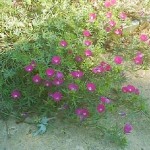
This native beauty was used by Native Americans. The roasted carrot-sized taproot supposedly tastes somewhat like sweet potato, but in the ground, the taproot thrusts itself into compacted soil to break it up. The leaves are edible cooked, with a mucilaginous texture that can be used as a thickener. Medicinally, poppy mallow leaves and roots can be used as a pain reliever. The Lakota used it as a medicinal smoke. This drought-tolerant perennial ground cover has a creeping behavior that will quickly cover that unsightly straw mulch. It’s gorgeous , fragrant flowers are the first in the guilds to emerge in April, persisting through August. Such early blooms will help attract pollinators so they’re already present to feast on apple blossom nectar. Not only are the blossoms of value to native bees, but this particular plant is a larval host to the gray hairstreak butterfly. Because of its low, creeping form, I chose to keep it at the edges of the beds where it can be admired and also help to blend the beds with their grass and concrete surrounds.
Birdsfoot Trefoil (Lotus corniculatus)

I proceeded with caution introducing this plant to the guild. In Minnesota, birdsfoot trefoil is considered a noxious weed. However, Minnesota is quite liberal with their invasive species stamp. Minnesota also has a notably different and wetter climate than South Dakota. In South Dakota, there is no mention of birdsfoot trefoil as a weed. Conversely, the ag communities suggest it as a forage crop and grazing pasture legume. As a foot traffic-tolerating ground cover, I couldn’t pass it up. It isn’t edible like clover, and although it has noted medicinal properties, we will not be using it as the presence of cyanogenic glycosides present too much risk to use without medical supervision. However, the flowers are extremely attractive to pollinators (and pretty), the roots are expansive and penetrating, it is much longer lived than clovers (meaning I don’t have to continually replant), it fixes nitrogen, and it forms a nice dense mat that will cover the straw and work as a living mulch to suppress weeds and keep the soil moist and cool.
Bush Beans (Phaseolus vulgaris)
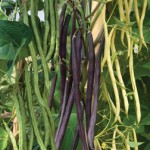
Bush beans provide two different crops and fix nitrogen. I needed no other reason to include these guys in the front guilds, although it helps that I was able to order some pretty varieties. Waiting in their packets to be planted are Amethyst Purple Stringless, Cherokee Wax, and Contender. Bush Beans are nice and compact needing no trellis, which is great, because nothing is tall enough to climb in the front guilds. The purple and yellow beans make them a little more ornamental.
Japanese Giant Red Mustard (Brassica juncea)

So gorgeous is this food crop that flower gardeners plant them only for their eye-catching beauty. Giant purple foliage creates contrast and is edible. Showy yellow flowers attract insects, add interest to cut flower arrangements, and are edible. Plentiful seeds mean it will resow itself and are renowned for seasoning and condiments. This variety has a “strong, sharp, almost garlic-like, mustard flavor. Tasty stir-fried or boiled and makes a great pickling variety,” according to the packet. That sounds great, because I am developing a desire to ferment everything that crosses my path. But even more magic happens in the ground. Mustard has deep, extensive roots that will break up my hardpan and accumulate nutrients for the guild.
Groundplum Milkvetch (Astragalus crassicarpus)
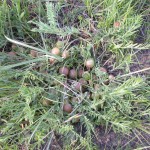
I did not draw this plant into the design, because I am planning to sow it throughout the beds as a nigrogen-fixing ground cover. I figured that the perennials will take more than one year to reach full size and several plants won’t make it, so this plant can fill in the spaces. Even if all the taller plants fill out quickly, groundplum grows rapidly and sets fruit early in spring — an advantage as a low growing plant in a tall grass prairie. Goundplum milkvetch is a native legume with edible fruits that taste similar to a garden pea when fresh. They can also be cooked or pickled. “The Dakota sometimes ate the fruits…fresh from the plant. The Pawnee, when traveling in the early summer, often picked these fruits and ate them to prevent thirst” (Kindscher 1987). It’s prettier before it sets fruit with its purple vetch-like flowers that, of course, attract insects, and its thick, woody taproots will break up the soil. Another native plant for the win.
Munstead Lavender (Lavendula angustifolia “Munstead”)

Who doesn’t love lavender? It’s gorgeous. It’s edible. It’s oh-so-fragrant. For most of my planning process, I had written off lavender for my zone 5. Then I found out that there is a particularly hardy variety, Munstead, that should overwinter here. I am planning for some winter deaths; collecting seed each year should do the trick. In the guild, lavender’s duty is to host beneficial insects and to attract pollinators. It’s also deer-resistant. Its human yields will be food, medicine, potpourri, cut flowers, dried flowers, tea, and beauty.
Bright Lights Swiss Chard (Beta vulgaris subsp cicla)

Okay, this plant really doesn’t do much for the guild, but it’s such a pretty edible, how could I leave it out of the front yard edible landscaping? It’s also a self-seeding annual, so I won’t have to replant every year if all goes to plan.
Garden Sorrel and Red-Veined Sorrel (Rumex acetosa and Rumex sanguineus)

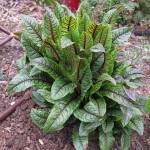
Sorrel has a sour, lemony flavor that kids love. I am so excited for these plants, as I think my boys will actually eat this veggie. They both love eating the little wood sorrel leaves from the yard, and I believe these leaves have a similar taste packaged in a much more manageable size. I am imagining playing with this green to make a lemon-drop type fruit leather packed with vitamins. Sorrel is a perennial green. This means not only do I not have to plant it, but it’s already got established roots so it can pop up before some annual green seeds have even sprouted. It also means that every few years I’ll be able to divide it and share with my community. Medicinally, sorrel is used as a cooling herb, taken to cool the body in fever and in summer temperatures. It is said to help with stomachache and vomiting. It can be gargled to cure mouth ulcers and applied topically to help with skin inflammation or as an astringent. In the guild, it may help to accumulate nutrients and can act as a green mulch if I have a lot left after human use.
Chives, Common and Garlic (Allium schoenoprasum and Allium tuberosum)
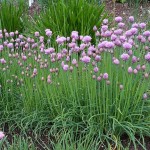
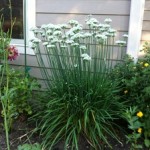
Chives are pretty and easy to grow. They’re another one of those culinary plants that many gardeners plant just for their beauty. Of course they are an edible herb, and we intend to use them as such. As members of the allium family, chives may also help to deter pests and are deer resistant. These plants are both perennials and will provide our family with highly nutritious herbs for years to come. Design-wise, chives’ grass-like looks will be a nice foliage shape contrast.
German Chamomile (Matricaria chamomilla)

A dainty wildflower with tiny flowers and delicate, ferny foliage, German chamomile will probably look its best after a few years of reseeding so that it can intermingle with the other flowers. Chamomile is edible and is renowned for its soothing and relaxing effects, but it is also used for so many conditions I won’t list them all here. This site has some great information. Chamomile is fragrant, especially when brushed against, and can be used to make potpourri. In the guild, German chamomile is a dynamic nutrient accumulator, attracts pollinators, hosts beneficial insects, and is deer-resistant.
Lupine (Lupinus albus and Lupinus angustifolius)
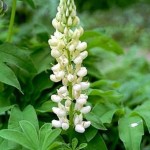

Edible lupines are not as showy as the ornamental cultivars, but they’re still beautiful with tall plumes of pea-like flowers. There is a native lupine to South Dakota, L. perennis, and it is also edible but apparently has a higher alkaloid content making them bitterer and requiring more preparation in order to safely eat. Since we have never tried lupin beans, I thought it would be good to start with these. Lupine beans require several days worth of soaking to rinse out the alkaloids, but they are worth it, containing the highest content of protein second only to soybeans. The Italians have long eaten “lupinis” soaked and packed in brine. Both of these species are annuals, but like the bush beans, I find them to be worth their presence in the guilds. Lupines are legumes and thus fix nitrogen, but it also means that they are probably not deer-resistant. Since they are packed into other deer-resistant plants, I’m hoping they will miss them. I’m very excited to try these beans.
Salad Burnet (Sanguisorba minor)
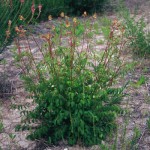
Salad burnet is another perennial green with unique flavor. I have not yet tried it. Some say it has a cucumber flavor; some say that that is an unfair comparison. Some love it, some hate it, which may be partly due to a difference of flavor from acid soil (bitter leaves) to chalky soil (milder flavor). Regardless, it is used as a flavoring rather than the bulk component of a salad. Medicinally, the root and leaves can be used to speed the healing of wounds and as an astringent effective with sunburns and eczema. In the guild, salad burnet has deep, extensive roots that will help break up my compacted soil. It is also a dynamic nutrient accumulator.
Calendula (Calendula officinalis)

As you can see, calendula, or pot marigold, is gorgeous. It’s flowers don’t stop at beautiful, though. They also attract insects and they are edible and medicinal. Medicinally, calendula is most widely known for skin healing. The flowers are used in creams, salves, soaps, lotions, and compresses. The leaves and flowers are used as a potherb and the flowers are used to make a healing tea. In the guild, calendula has deep tap roots that will break up the soil and attracts insects. A self-seeding annual, I expect calendula to spread throughout the guilds and mingle with the other plants in cheery fashion.
Red Yarrow (Achillea millefolium “Rubra”)
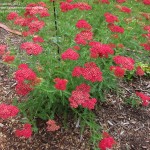
Yarrow is so pretty. It’s also weedy, which usually means it’s chock-full of uses. Yarrow is no exception. This is one of those plants that I chose to include although it will require diligent tending to keep it in bounds; here’s why. Yarrow is an edible herb and tea. It is highly medicinal, most well-known for stopping blood flow in open wounds (Achillea comes from Achilles, the Greek god with the severed tendon). It is deer resistant. It’s ferny foliage creates contrast but also hosts beneficial insects. Its small flowers in flat clusters are highly attractive to insects of all kinds. It is a dynamic nutrient accumulator. Its deep roots will break up the soil. Its fragrant flowers can be dried and used in potpourri and arrangements. And did I mention it’s pretty?
Purple Coneflower (Echinacea purpurea)
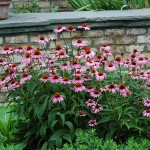
Another native beauty, purple coneflower is also tough and useful. This plant was already in the landscaping when we moved in, so it was a no-brainer to include it in the guilds. You may have heard of echinacea; it comes in tea and pill form to stave off oncoming colds. It has deep roots to help break up the soil and attracts all kinds of insects. Its seeds also attract finches who are a delight to see perching on top of the flowers. So far, the deer have not touched these plants.
Bronze Fennel (Foeniculum vulgare var. Purpureum)
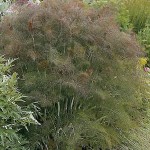
My family is in love with fennel. Besides pizza, fennel seeds are the one thing everyone in my family will eat. Sometimes we toast them, sometimes we eat them raw. I carry a bottle of them around with me in my purse for breath mints. In addition to breath freshening, fennel also helps digestion after a big meal and cures slight stomach aches. I also make a tea from the crushed seeds that has a lovely, sweet aftertaste. Of course we use it as a seasoning in cooking as well. Once we have these plants going, I can’t wait to line my bread pans with the fronds and try my hand at candied fennel stems. This is herb fennel. It’s a perennial, unlike Florence fennel, and doesn’t have a swollen bulb at its base. However, the entire plant is edible: stems, leaves, flowers, pollen, seeds (as is usually the case with vegetables versus fruits). It’s got that sweet anise flavor that’s reminiscent of black licorice. Medicinally, fennel is used for stomach problems and coughing or wheezing. In the guild, this plant is a standout. Ornamentally, fennel’s feathery, bronze leaves provide contrast and interest, and it’s tall yellow flowers add even more whimsy. Practically, these leaves are a prime egg-laying spot for beneficial insects, and predatory wasps adore umbels of all kinds. I’ve also seen monarchs going crazy over umbels. Fennel’s deep, multi-stemmed taproot will assist the other deep roots in breaking up my poor, abused soil, but it’s also a dynamic nutrient accumulator. Although zone 5 is pushing it for this perennial, it will readily reseed itself. Fennel is a knockout and a standout, and I simply couldn’t design enough of this magical, smoky beauty into my guilds.
Borage (Borago officinalis)
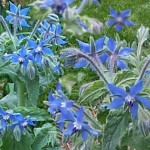
Borage seems to me to be a humble plant, for its flowers are so beautiful, they look down so as not to outshine any other plant. This self-seeding annual is fuzzy all over and is thus a great host to beneficial bugs of all kinds. That also means the deer won’t eat it. Before it gets all fuzzy, the young leaves are edible and have a light cucumber taste. As long as the flowers are blooming, they are edible too, and also have a slight cucumber taste. I’ve seen the flowers frozen into ice cubes, topping desserts, and garnishing salads. The flowers are also bee heaven. Borage is cultivated commercially for its seeds which are pressed for oil which is marketed for relief for arthritis. Borage has many medicinal properties and is used for arthritis, adrenal support in times of stress, as a diuretic, for gastrointestinal issues, and topically for skin issues. Borage contains nontoxic and toxic properties, so it shouldn’t be consumed in great quantities (as with most plants that are edible and have medicinal properties). Borage has a deep taproot that will break up the soil and is noted to be a dynamic accumulator. Borage also seems to be a pest deterrent and is often planted along with food crops like tomatoes and strawberries. Design-wise, I’ve looked at picture after picture, and this plant must really vary with conditions and even with specific genetics. It’s also a bit gangly. If you work it right and hide the base with other plants, you can take full advantage of those billowy, blue flowers. As a self-seeder, it may take some work to keep it in the right places so it’s sightly to more people. I think it’s beautiful, but then again I haven’t found many things (or people) that aren’t.
Chicory (Cichorium intybus)
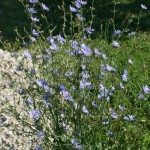
You may have heard of chicory as a coffee substitute. Chicory is dandelion’s cousin, but prettier and apparently less bitter. Like dandelion, the taproot is edible and used as a coffee substitute, the leaves are edible (better before flowering), and the flowers are edible. Medicinally, chicory is used for gastrointestinal problems, as a diuretic, to slow rapid heartbeat, and externally for swelling and skin inflammation. This perennial spreads by seed, attracts insects, breaks up soil, and works as a dynamic nutrient accumulator. The tall sprays of blue flowers will add a whimsical touch to the guilds. They particularly seem to pair well with white umbels, and I don’t have any in the guild this year. I may add some Queen Anne’s lace to pair it with next year.
Leadplant (Amorpha canescens)
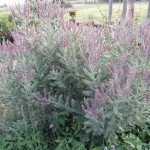
A native prairie legume, leadplant is also called (among many other names) bird’s tree, because its height in the treeless prairie makes it a perfect perch for birds. Leadplant is not edible but its leaves are used to make tea, thus another of its names, wild tea. Medicinally, the leaves are astringent and so are used to stop bleeding in wounds and cure skin problems. A decoction of the root is said to cure stomach pains. Leadplant’s main role in my guilds is nurse to the trees. I’ve placed several of these shrubs around both apple trees to fix nitrogen and share it with the trees. Their massive size below ground means more nodules, more rhizobia, and hopefully, more nitrogen to share. The extensive root systems will break up the soil as well. Each purple flower spike is actually a collection of dozens of flowers, each one consisting of one purple petal and several bright orange stamens. If you’ve seen this plant in person, you may know what I mean when I say it’s hard to take your eyes away from it. These eye-catching flowers also provide plenty of nectar for our flying friends.
Anise Hyssop (Agastache foeniculum)

Anise hyssop is another native prairie plant. According to Kindscher in Edible Wild Plants of the Prairie, the Native Americans of the Missouri River region used the leaves for tea and flavoring, the Lakota chewed the leaves, and the Cree included its flowers in medicine bundles. You can probably guess why anise hyssop has the name it does — it’s another black licorice plant. We haven’t tried this plant yet, but I’m hopeful that my family will love it as much as we love fennel. Both the leaves and flowers are edible. Medicinally, anise hyssop works a bit like fennel. It can be used to prevent stomach upset and gas, and a tea can help with respiratory problems.The flowers retain their color and fragrance when dried and so will make a nice potpourri or incense. The flowers are highly coveted by bees, butterflies, and hummingbirds, and goldfinches like its seeds. A member of the mint family, this plant readily reseeds, and I am prepared to look for many volunteers each spring.
Orach (Atriplex hortensis)
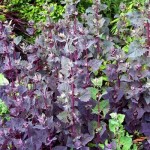
I picked orach for its edible beauty. The packet of seeds I bought, called Aurora, includes purple, magenta, chartreuse, and green. Orach is tall and stately, and will add some much needed foliage contrast into the guilds. It’s a self-seeding green, which makes it more at home up front than in the rotated backyard beds. If you look closely, you’ll see its leaves look much like the edible weed lamb’s quarters. Indeed they are closely related, and both orach and lamb’s quarters belong to the family Chenopodioideae, the same family as our beloved spinach.
Comfrey (Symphytum officinale)
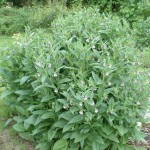
Ah comfrey, the quintessential permaculture plant. Comfrey is not edible but has a long history of medicinal use in speeding the healing of broken bones and wounds and moisturizing skin. A relative of borage, comfrey flowers have the same bee appeal. I’m starting to think I should get a small hive! It’s a dynamic nutrient accumulator with deep roots that break up the soil. As you can see, I’ve employed a lot of plants to slowly “till” the soil for me, the benefits of which are so numerous, it merits its own blog post. Quick-growing comfrey has large, soft leaves that can be harvested several times a season for medicine, green manure, or compost tea. The leaves break down quickly into an amazing fertilizer when just laid in place. Many gardeners have experienced nightmares with comfrey as a “weed” at no fault to the plant. If you have a variety that sterile, you don’t have to worry about self-seeding. If you have a non-sterile variety, you still may not have to worry if you utilize the leaves by chopping down the plant. Otherwise, just cut off the blossoms before they set seed. The real problem comes in when comfrey’s roots are disturbed. Therefore, if you try to till it in, you will most certainly make hundreds of comfrey babies. In my design, I took care not to plant comfrey next to plants that I plan to pull up, such as chicory and purple poppy mallow.
Lovage (Levisticum officinalis)
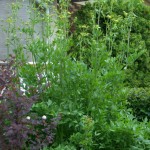
Aside from the apple trees, lovage is the tallest plant in my front guilds. Its towering height is reached when it begins to flower. Lovage is a perennial green with a very strong celery taste. In the kitchen, you can use lovage leaves and stalks much like you would celery, using a much smaller quantity. The seeds are also used as seasoning. Another aromatic herb, this stately plant is used for stomach problems and gas. I have also read that it is an effective deodorant externally — allowing the sweat to leave the body as naturally intended while eliminating odor. Lovage is in the Umbelliferae family, so it hosts swallowtails and attracts insects of all kinds, including beneficial and predatory insects. I especially love the bright green color of lovage, which I think will look stunning next to purple orach.
Kindscher, K. (1987). Edible wild plants of the prairie: An ethnobotanical guide. Lawrence, Kan.: University Press of Kansas.
Hemenway, T. (2009). Gaia’s garden: A guide to home-scale permaculture (2nd ed.). White River Junction, Vt.: Chelsea Green Pub.